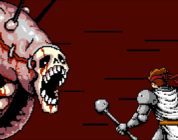Our review for Middle-Earth: Shadow of Mordor is glowing, but I decided to cut a few hundred words out and set them aside on their own. These few hundred words address a simple, but important question: Does Middle-Earth: Shadow of Mordor fit within Tolkien’s established world? In the review, I answered “Mostly,” and that’s better than many attempts have been. As with Lord of the Rings: War in the North, Shadow of Mordor takes place alongside the stories Tolkien told, rather than attempting to insert itself directly into them. While War in the North took place concurrently with Lord of the Rings, Shadow of Mordor takes place between the events of The Hobbit and The Lord of the Rings, almost immediately after the final events of The Hobbit; a time which is only lightly referenced in The Lord of the Rings. These light references, while they do establish the correct timeline for the presence of one of the characters you meet, they do not go into enough depth to preclude the game’s story from taking place.
For those who have studiously avoided spoilers regarding the Wraith, here there be spoilers. If you want to avoid it, just skip on to the last paragraph. The Wraith is Celebrimbor, one of the greatest Elven smiths, and crafter of the Rings of Power. His presence is…questionable. To become a Wraith, one must either be raised through necromancy, killed “in darkness,” or subject to the power of the Rings. There are very few examples of non-Ringwraiths, and no examples that I recall of Elven Wraiths (and none I could find in my research). That said, there’s no statement (that I could find, at least) that outright establishes Elven immunity to Wraithhood. If we accept the leap that Elves can become Wraiths, then Celebrimbor’s canonical death at the hands of Sauron and the necromancy used to bind him in the opening of the game is not an unreasonable explanation for his presence.
The biggest discrepancy between the game and Tolkien’s established world is that the use of power to dominate the will of another creature is reserved for the evil. It is categorically a negative extension of power. To have the protagonist growing stronger and stronger in the powers of Celebrimbor, regardless of motivation, is somewhat contradictory. Even more so when you understand who the Wraith really is. The methods of the Enemy would never be Celebrimbor’s methods, especially after Annatar (Sauron) betrayed him and destroyed him. To see Celebrimbor become more and more like the power he detests borders on disrespect to Tolkien’s character, who was prideful, but not evil.
Other than this major element, Middle-Earth: Shadow of Mordor feels like Lord of the Rings, and that’s a fantastic thing. The dialogue and behavior of the orcs perfectly captures them, as do the character designs. The hierarchy system employed by the orc army is also just what you’d expect from Tolkien’s orcs, and the sheer diversity in their methods and madness is delightful. And that’s it for the Tolkien connection. Like I said, I’d try to keep it to a minimum. Some assumptions were made, and some liberties were taken, but overall the game did a decent job of setting itself neatly into the events leading up to the War of the Ring without outright contradicting (maybe bending a bit, or slightly warping) any of the established canon. And in a canon as extensive and intricate as Tolkien’s, that’s an accomplishment. It should just be made perfectly clear that though it doesn’t outright break canon, Shadow of Mordor is *not* Tolkien canon, and with that in mind, it becomes much more entertaining.






